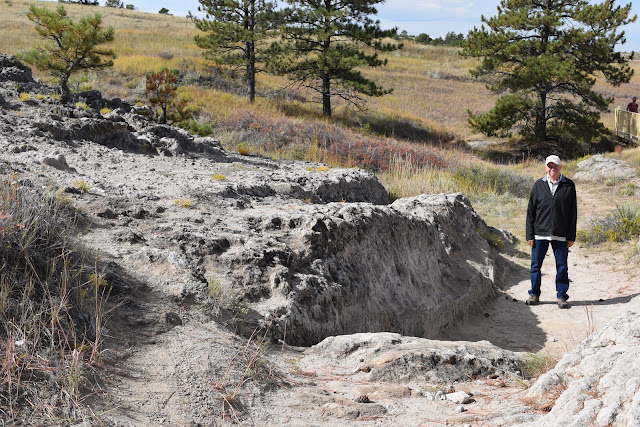 |
| Fred standing in the wagon ruts on the Oregon Trail |
September 30, 2017
Fort Laramie, Wyoming
Our journey south to warmer weather and less smoky conditions continued with a stop in Fort Laramie, Wyoming.
This tiny western city provided a pleasant stopover for us to visit 2 local landmarks that were pointed out to us by friends and fellow fulltime RVers Mike and Connie Johnson who had passed this way earlier in 2017.
We were impressed by their photographs of the Oregon Trail ruts and wanted to see them for ourselves.
The National Frontier Trails Museum in Independence Missouri had given us an introduction to the western trails system when we paid a visit there in late July. We crossed the auto route paths of the Oregon, California, Pony Express and Santa Fe trails several times over the summer and were looking forward to standing in the footsteps of those intrepid adventurers.
 |
| The ruts are as deep as 5 feet in places |
Guernsey Wyoming is home to Deep Rut Hill where some of the most enduring and dramatic examples of the trail are preserved.
Here the trail leads away from the North Platte River and across a sandstone ridge. The topography of the land required a single file formation where wagon after wagon outfitted with iron wheels cut into the soft stone.
The ruts are an impressive site. In some places they are 5 feet deep. It was exciting to be able to stand in them and picture the creaking wagons and tired travelers that had climbed the hill. These deep ruts are preserved as part of the Wyoming State Park System. We met folks in town that speak of the ruts as a normal part of their environment. They run through a local golf course and through the Army Reserve Base near by.
The park includes several examples of the CCC’s Rustic Architecture style including a stone and log picnic shelter that was built in 1937.
 |
| Rustic Architecture shelter made by the CCC in 1937. |
I was here.
I made it this far.
 |
| Signatures on the Register Cliff |
 |
| We found a familiar name. |
At one point there was a trading post here, A cave carved into the rock provided cold storage and grassy fields nearby provided a place for livestock to graze. The Trading Post at Register Cliff was a stop on the Pony Express Trail and later a Stagecoach Stop.
Fort Laramie originally established in 1834 was once the largest military outpost on the Great Plains. The westward trails to Oregon, California, Santa Fe and Utah all passed through the fort.
It was a supply depot for restocking and provided a place to bathe, wash clothing and rest for a few days. Fort Laramie was also a stop for the Pony Express.
The fort served as a base of operations during the Indian Wars that followed westward expansion as native americans fought to hold on to their disappearing way of life. We were told that soldiers in Fort Laramie were first responders to emergency situations as far away as the Black Hills of South Dakota. It is hard to imagine the amount of time it would have taken for them to respond to such a request.
 |
| These limestone ruins were once a 12 bed hospital. |
The fort is an interesting combination of ruins and reconstructed buildings furnished with period artifacts. The barracks building is set up including a dining hall and kitchen area. Officers quarters were separate houses that provided room for families.
 |
| Enlisted men's barracks. |
The limestone ruins include an administration building, a 12 bed hospital and a bakery. They are very well tended to keep them from deteriorating any further.
 |
| The Army Iron Bridge was park of the Oregon Trail |
Still standing is the Army Iron Bridge built over the North Platte River to provide a safe crossing for immigrants traveling west and for the Army to respond to the East.
Fort Laramie hosted a score of famous western figures including Kit Carson, Jim Bridger, General William Tecumseh Sherman, Wild Bill Hickock, Calamity Jane and Buffalo Bill all slept here.
The Fort was decommissioned after the Indian Wars and was sold at public auction in 1890. Most of the buildings were pulled apart to provide materials for newer structures. Preservation and reconstruction efforts began in 1938 when it became part of the National Park System.
 |
| Old Bedlam was the name of the Bachelor Officers |
Fort Laramie National Historic Site
965 Gray Rocks Rd
Fort Laramie, Wyoming
Army Iron Bridge
Fort Laramie, Wyoming
Oregon Trail Ruts
1 mile south of
Guernsey, Wyoming
Register Cliff
2 miles west of ruts
Guernsey, Wyoming



No comments:
Post a Comment